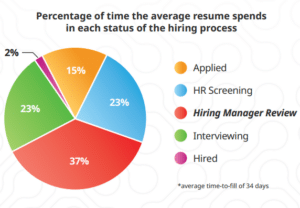How to Identify Bottlenecks in Your Recruitment Process

By Sharlyn Lauby
We all know what a bottleneck is, right? It’s the stage in a process that causes the entire process to stop, slow down, or be less effective. I learned a lot about bottlenecks in Dr. Eliyahu Goldratt’s book “The Goal”. The book is about the Theory of Constraints and a bottleneck is (obviously) a constraint. I don’t want to give the whole book away, but it discusses how to identify and manage constraints successfully.
A first step in successfully dealing with bottlenecks is identifying them. You know how this works. If you only deal with a symptom then you never really fix the problem. It’s about getting to the root cause.
Take recruiting for example. When the recruiting process is broken, everybody knows it. And in my experience, everyone blames everything on recruiting being broken.
“We can’t finish the project on time because we don’t have enough people.”
“We can’t deliver good service because we don’t have the right people.”
“I really need to fire Bob, but if I do I’ll never find his replacement.”
Problems (or contraints) in recruiting isn’t something to ignore because finding top talent is essential to the business. The question becomes, how do you identify the constraint (i.e. bottleneck) in the process?
Since recruitment is a process that involves multiple people: human resources, hiring manager, payroll, and possibly other individuals, we can start with an analysis of how the process works. For example, do you know who spends the most time with resumes during the hiring process?
The answer isn’t human resources.
I found this chart from iCIMS’ latest research on “Strategies to Improve the Recruiter and Hiring Manager Relationship” to be very interesting. The hiring manager spends the most time with resumes.
That piece of information really created additional questions for me. Here are four that immediately came to mind:
- Who should spend the most time with resumes? Should it be the hiring manager?
- What is each person actually doing with the resumes? What should they be doing?
- Big picture, what is each person’s responsibility in the process? Does each person know their role? Do they know each other’s roles?
- Is each person capable of completing their role in the process?
In order to identify the constraint, these questions must be answered. Organizations need to know that the process they’ve designed on paper is the process that actually happens. They need to know that each person in the process knows their role and is capable of doing it. And that each person knows their role in the context of the other people involved in the process.
That’s why I’m starting to think that organizations are going to begin making investments in developing high-performance recruiting teams. Many companies invest in team building for departments. Sometimes in team development for project teams. Recruiting teams are the group of people identifying and selecting the employees who will service customers, create the next company innovation, and be the future leadership. It only makes sense to create a development initiative for this team.
Which brings us back to bottlenecks and constraints. Is it possible that, if a company asked themselves those four questions, they would find the source of their bottleneck? Once the constraint is identified, then it can be appropriately managed. Here are three action steps that could correct the bottleneck:
Process communication. To make sure that steps in the process are not being duplicated or accidently forgotten, the process can be communicated to all stakeholders.
Role reinforcement. Make sure each person who has a role in the process knows their tasks and accepts responsibility for their completion.
Training. Any individual who needs skill development should be provided the opportunity to become proficient..
If organizations want to employ top talent, they have to create effective processes and troubleshoot those processes to keep them the best they can possibly be.







